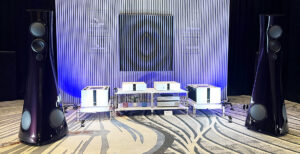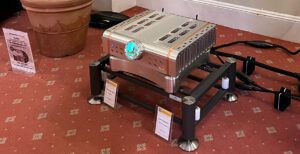
High-resolution audio (HRA) has had something of a mixed start in life. Touted as the Next Big Thing by the Consumer Technology Association before it was the Consumer Technology Association, the impact of good quality audio seemed not to make as big an impact as other notable flavours of the tech month. Wearables, ‘hoverboards’, and miscellaneous shiny gadgets quickly swamped HRA. The battle seemed lost; CD is in decline, low-resolution streaming is on the rise, and high-resolution seems the preserve of the aging audiophile community.
Or, at least, that’s how it seemed.
In fact, music played at CD resolution and beyond is quietly thriving, and growing in interest, especially in many Asian markets. Although still considered a niche, the growth of interest in HRA has caught the attention of a number of cellphone makers and telecoms providers, according to a recent report from Reuters (http://www.reuters.com/article/us-tech-audio-idUSKCN0X82NR).
In the report, the reversal of fortunes of iRiver (now better as Astell&Kern), which has moved from near-bankruptcy to profitability in a just a few years is seen as an example of the change in this entire sector of portable audio. The brand was foundering when it made low-end MP3 players under the iRiver name, but now it relaunched itself as Astell&Kern and makes high-performance, luxury high-resolution players, and is now selling models like the AK380 costing up to $3,000, the company has of considerable benefit to its financies. One might be tempted to say ‘of course’, but if the market for high-end, high-resolution players simply was not there, then moving from MP3 to HRA would not be a recipe for revenue.
A&K is not alone in this. We have heard similar reports from a number of DAP and headphone makers, most notably Lotoo with its PAW Gold player and Questyle with its QP1R.

The writer, Jeremy Wagstaff, having visited CanJam Singapore, notes that an audience of young, professional Asian men are reacting to changes in their lifestyle and housing by eschewing traditional audio for a more portable audio world. This is entirely understandable; out cash-rich, time-poor world, coupled to the unfeasible cost of real estate in the big cities across the world, means people demand the best possible sound from devices that suit these environments, and they are ready, willing, and able to afford them.
It’s remarkable just how far this market has developed, and how fast. When Apple essentially ceded a lot of its upper-tier iPod market to the iPhone and iPad, spending a more than few hundred dollars on a digital audio player seemed impossible and absurd. Now, in some markets, the average expenditure on a DAP is closer to $1,000.
In part, the increased success of standalone DAPs and HRA files is in response to ever increasing mobile and domestic broadband connectivity. South Korea leads the field here; Seoul is considered the Wi-Fi capital of the world, and download speeds across the city mean it’s possible to access high-resolution audio files on the move with greater ease and speed than practically anywhere else on the planet, even though the rest of the planet is catching up fast. So, it’s perhaps little wonder that telecoms companies and phone makers in South Korea are regarding this burgeoning high-res market with envious eyes. When you think on it, a group of cash-rich bandwidth power users who will happily subscribe at a premium for an audio downloading service, is a demographic worth pursuing if you are the provider of the bandwidth and the subscription! Little wonder then that the feature lists companies like the Korean SK Telecom and Singapore Telecommunications as interested parties in this next wave of high-performance audio.
We can’t help but see this as an important part of the future of audio outside of Asia as well as inside. With ever-increasing mobile data rates, concepts like MQA gaining ground beyond the audio community, ever more professionals locked into twice-daily a commuter hell, and real estate prices squeezing those professionals into smaller premises, the need for good audio in very small spaces is universal in its appeal. Although audio’s legion of Social Justice Warriors in the Will happily play self-appointed protectors of other people’s bank-balances, the drive to get a better experience among those who can afford to enjoy the process looks set to continue.
We also feel this is both validation and vindication of our direction toward the headphone space in recent years. There is still a lot of reticence to explore a smaller audio habitat among ‘traditional’ audiophiles, and this can get somewhat heated at times as they feel their world is being swept away by the in-head ingress. But we feel these are just two sides of the same coin and can peacefully coexist.
Reading this market, though, what does seem clear at the moment is it’s one-directional. People with existing two-channel high-end stereo systems can – and do – discover the joys of headphones, custom in-ear monitors, headphone amps, DACs and the rest of this new world. But, at this time, there isn’t a significant amount of movement in the other direction, and headphone enthusiasts are not discovering how good loudspeakers and high-power amplifiers can be. Maybe this will change in time, or maybe – just maybe – it reflects how some traditional audio manufacturers need to climb out of their ivory towers and look at how the world has changed, and how they need to make products that meet the needs of the new bloods.
Tags: FEATURED
By Alan Sircom
More articles from this authorRead Next From Blog
See all
AXPONA 2024 Show Report Part One
- Apr 19, 2024

Audio Show Deluxe 2024: A photo show report
- Mar 28, 2024

Paul Messenger 1949-2024: A personal tribute
- Mar 26, 2024

Bristol Hi-Fi Show 2024: See You There!
- Feb 21, 2024










